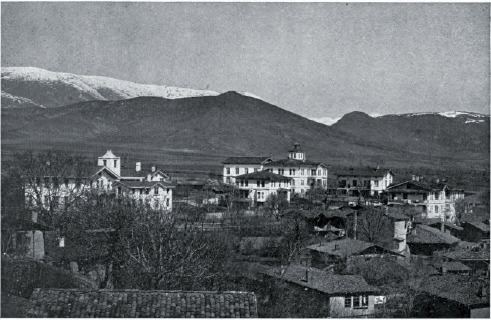Founded 1864 | ||
 | ||
The Anatolia College in Merzifon or American College of Mersovan (Turkish: Merzifon Amerikan Koleji) was a coeducational high school located in the town of Merzifon in the Rûm Province of the Ottoman Empire (in modern-day Amasya Province, Turkey) established and directed by American missionaries between 1886 and 1924.
Contents
Theological seminary
The American Board of Commissioners for Foreign Missions established the school in 1864 as a theological seminary after the American college in Bebek, İstanbul, the later Robert College, abandoned its theological training and concentrated in only general education due to growing number of young people interested in English language. The school in Merzifon served in the beginning to educate the children of the Greek and Armenian community in Anatolia, who wanted to become pastors or preachers.
College
In 1886, as more and more young people wanted a general education, the program at the theological seminary in Merzifon was expanded to include a four-year liberal arts college. The institution was named Anatolia College, and Charles Tracy became the first president, serving until 1912. The college's motto was "The Morning Cometh" referring to the ancient Greek word for dawn, as well as the region "Anatolia". The college seal showed the sun rising over lofty Akdağ at the eastern end of the Merzifon Plain. The over 100 students, principally Greek and Armenian, came most from outside of Merzifon and boarded at the school. The faculty was Greek, Armenian, and American. The half-German J. J. Manissadijan was Professor of Botany and also founded a college museum.
When Armenian activists posted broadsides in 1893, Ottoman troops jailed many Armenians and damaged some college buildings; accusing Armenian students and teachers of being in contact with the rebels. The damage was rebuilt later with compensation paid by the Ottoman Government. The college was incorporated under the laws of the State of Massachusetts in 1894. The Armenian Genocide came to Anatolia College in August, 1915, when Islamic forces broke into the campus and seized Armenian faculty and students. Many were murdered on the spot; the others were marched off for "deportation" (in fact a death march). This atrocity became known to the west when George E. White (missionary), President of the college at the time, returned to the United States in 1917 and described the scene to a New York Times reporter.
. After the end of the WWI, the facilities of the college at the campus consisted of a kindergarten, a school for the Deaf, a college-level program, one of the largest hospitals in Asia Minor, and an orphanage for 2,000 orphans in addition to the theological seminary and high schools for boys and girls, all housed in more than 40 buildings of New England style. The activities of the American missionaries came de facto to an end with the collapse of the Ottoman Empire in 1918.
In 1921 the Turkish nationalists under Mustafa Kemal hanged in Amaseia three teachers and several students of the college. The latter were charged with plotting armed rebellion.
Relocation to Greece
After the Greco-Turkish War (1919–1922) and subsequent population exchange between Greece and Turkey, the college was closed in Merzifon to be reopened in Thessaloniki, Greece in 1924, as Anatolia College.
Book about the College
American missionary George E. White, who was a teacher from 1890 and president from 1913 until 1921 at the school in Merzifon, wrote his memories in a book Adventuring With Anatolia College.
